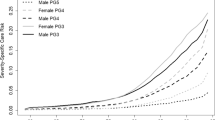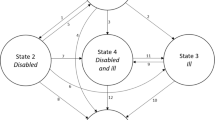Abstract
In an insurance context, Long-Term Care (LTC) products cover the risk of permanent loss of autonomy, which is defined by the impossibility or difficulty of performing alone all or part of the activities of daily living (ADL). From an actuarial point of view, knowledge of risk depends on knowledge of the underlying biometric laws, including the mortality of autonomous insureds and the mortality of disabled insureds. Due to the relatively short history of LTC products and the age limit imposed at underwriting, insurers lack information at advanced ages. This represents a challenge for actuaries, making it difficult to estimate those biometric laws. In this paper, we propose to complete the missing information at advanced ages on the mortality of autonomous and disabled insured populations using information on the global mortality of the portfolio. In fact, the three previous mortality laws are linked since the portfolio is composed only of autonomous and disabled policyholders. We model the two mortality laws (deaths in autonomy and deaths in LTC) in a Poisson Generalized Linear Model framework, additionally using the P-Splines smoothing method. A constraint is then included to link the mortality laws of the two groups and the global mortality of the portfolio. This new method allows for estimating and extrapolating both mortality laws simultaneously in a consistent manner.














Similar content being viewed by others
Data availability
Due to the sensitive nature of the data used in this paper and the competitive advantage they might represent for private insurance and reinsurance activitives, the data is not available publically.
References
Alegre A, Pociello E, Pons A, Varea J, Vicente A (2003) Actuarial valuation of long-term care annuities. Insur Math Econ 32
Barbi E, Lagona F, Marsili M, Vaupel JW, Wachter KW (2018) The plateau of human mortality: demography of longevity pioneers. Science 360(6396):1459–1461
Biessy G (2015) Long-Term Care insurance: a multi-state semi-Markov model to describe the dependency process in elderly people. Bull Français d’Actuariat 15(29):41–73
Bollaerts K, Eilers P, Mechelen I (2006) Simple and multiple P-splines regression with shape constraints. Br J Math Stat Psychol 59:451–69
Brass W (1971) Biological aspects of demography. Taylor and Francis, USA
Camarda C (2019) Smooth constrained mortality forecasting. Demogr Res 41:1091–1130
Camarda CG, Eilers PH, Gampe J (2016) Sums of smooth exponentials to decompose complex series of counts. Stat Model 16(4):279–296
Currie ID, Durban M (2002) Flexible smoothing with P-splines: a unified approach. Stat Model 2(4):333–349
Currie ID, Durban M, Eilers PH (2004) Smoothing and forecasting mortality rates. Stat Model 4(4):279–298
Dupourqué E (2012) AGGIR, the work of grids. Long-Term Care News 32
Eilers PHC, Marx BD (1996) Flexible smoothing with B -splines and penalties. Stat Sci 11(2):89–121
Eilers PHC, Marx BD (2002) Generalized linear additive smooth structures. J Comput Graph Stat 11(4):758–783
Eurostat (2022) Population structure and ageing, pp 575–94
Fleischmann A (2015) Calibrating intensities for long-term care multiple-state Markov insurance model. Eur Actuar J 5:327–354
Gavrilov L, Gavrilova N (2019) New trend in old-age mortality: Gompertzialization of mortality trajectory. Gerontology 65:1–7
Guibert Q, Loisel S, Lopez O, Piette P (2020) Bridging the Li-Carter’s gap: a locally coherent mortality forecast approach. https://hal.archives-ouvertes.fr/hal-02472777
Hammond M (2000) The forces of mortality at ages 80 to 120. Int J Epidemiol 29(2):384–384
Li JS-H, Chan W-S, Zhou R (2017) Semicoherent multipopulation mortality modeling: the impact on longevity risk securitization. J Risk Insur 84(3):1025–1065
Li N, Lee R (2005) Coherent mortality forecasts for a group of population: an extension of the Lee-Carter method. Demography 42:575–94
Macdonald AS, Richards SJ, Currie ID (2018) Modelling mortality with actuarial applications. Cambridge University Press, Cambridge
Marx BD, Eilers PH (1998) Direct generalized additive modeling with penalized likelihood. Comput Stat Data Anal 28(2):193–209
Max Planck Institute for Demographic Research (Germany), University of California, Berkeley (USA), and French Institute for Demographic Studies (France) (2020). Human mortality database. https://www.mortality.org
Nuttall SR, Blackwood RJL, Bussell BMH, Cliff JP, Cornall MJ, Cowley A, Gatenby PL, Webber JM (1994) Financing long-term care in Great Britain. J Inst Act 121(1):1–68
Porta N, Gomez G, Calle M, Malats NR (2007) Competing risks methods. https://upcommons.upc.edu/bitstream/handle/2117/2201/TR_CR.pdf
Remund A, Riffe T, Camarda C (2018) A cause-of-death decomposition of the young adult mortality hump. Demography 55:957–978
Ruppert D (2000) Selecting the number of knots for penalized splines. J Comput Graph Stat 11:735–757
Zhou R, Xing G, Ji M (2019) Changes of relation in multi-population mortality dependence: an application of threshold VECM. Risks 7(1)
Acknowledgements
I would like to express my gratitude to my PhD supervisors Christian Robert and Stéphane Loisel from the SAF laboratory, for providing guidance and feedback throughout this project. I am also grateful to the anonymous reviewers, the Editor-in-Chief and the Handling Editor for their useful comments on a previous version of this manuscript. Finally, I would like to thank Razvan Ionescu, head of Biometric Risk Modelling at SCOR, and my colleague Tiziana Torri, who both oversee my research as a PhD candidate at SCOR, and have provided invaluable help throughout the writing of this paper.
Author information
Authors and Affiliations
Corresponding author
Additional information
Publisher's Note
Springer Nature remains neutral with regard to jurisdictional claims in published maps and institutional affiliations.
Appendix A: Convergence of the Newton Raphson algorithm
Appendix A: Convergence of the Newton Raphson algorithm
To be the maximum penalized likelihood estimator of \(\varvec{\theta }\), the Hessian matrix \(H_{\widehat{\varvec{\theta }}}\) at the final step of the algorithm has to be negative semi-definite.
Let us analyse the Hessian matrix.
-
The first term \(-B^T W W_{\varvec{\theta }}B\) is negative semi-definite for all \(\varvec{\theta }\). Indeed, recalling that \(W_{\varvec{\theta }}\) is diagonal with only non-negative terms,
$$\begin{aligned} h^TB^TW_{\varvec{\theta }}Bh = (Bh)^T W_{\varvec{\theta }}(Bh) \ge 0 \, \quad \forall h \in \mathbb {R}^{2M}. \end{aligned}$$ -
The second term \(-P\), which does not depend on \(\varvec{\theta }\), is also negative semi-definite. Indeed, from 2.3, we know that \(P_d = D_d^T D_d\). Therefore, \(h^T P_d h \ge 0 \, \quad \forall h \in \mathbb {R}^{2M}\).
-
The third term \(- KB^T \left[ W_{\varvec{\theta }} \left( [(\tilde{W}_3^{-1})^2 W_{\varvec{\theta }}^Q ] \otimes I_2 \right) \right] B \) is not necessarily negative semi-definite for all \(\varvec{\theta }\). In fact, the weight matrix \(\left[ W_{\varvec{\theta }} \left( [(\tilde{W}_3^{-1})^2 W_{\varvec{\theta }}^Q ] \otimes I_2 \right) \right] \) is diagonal, but not all coefficients are greater than 0 for some \( \varvec{\theta }\). The terms of the diagonal matrix are non-positive if some terms of \(W_{\varvec{\theta }}^Q \) are non-negative. This is the case when
$$\begin{aligned} \lambda ^{A}_{\varvec{\theta },x} e^A_{x} + \lambda ^D_{\varvec{\theta },x} e^D_{x} \le \lambda _{x}^{gen} [ e^A_{x} + e^D_{x} ],\hbox { for some } x_{min} \le x \le x_{max}. \end{aligned}$$ -
The fourth term \(-K \begin{bmatrix} \tilde{W}_3^{-1} W_{\varvec{\theta }}^{A} B_{A}&\tilde{W}_3^{-1} W_{\varvec{\theta }}^{D} B_{D} \end{bmatrix}^T \begin{bmatrix} \tilde{W}_3^{-1} W_{\varvec{\theta }}^{A} B_{A}&\tilde{W}_3^{-1} W_{\varvec{\theta }}^{D} B_{D} \end{bmatrix}\) is negative semi-definite for all \(\varvec{\theta }\). In fact,
$$\begin{aligned}&h^T \begin{bmatrix} \tilde{W}_3^{-1} W_{\varvec{\theta }}^{A} B_{A}&\tilde{W}_3^{-1} W_{\varvec{\theta }}^{D} B_{D} \end{bmatrix}^T \begin{bmatrix} \tilde{W}_3^{-1} W_{\varvec{\theta }}^{A} B_{A}&\tilde{W}_3^{-1} W_{\varvec{\theta }}^{D} B_{D} \end{bmatrix} h \\&\quad = \left\| \begin{bmatrix} \tilde{W}_3^{-1} W_{\varvec{\theta }}^{A} B_{A}&\tilde{W}_3^{-1} W_{\varvec{\theta }}^{D} B_{D} \end{bmatrix} h \right\| _2^2 \\&\quad \ge 0 . \end{aligned}$$
Then, a sufficient condition for \(H_{\varvec{\theta }}(l_{pen})\) to be negative semi-definite and therefore for \(\widehat{\varvec{\theta }}\) to be the optimal parameter is that the third term is negative semi-definite. The condition is given by
This means that the sum of the predicted number of deaths in states A and D has to be lower than or equal to the predicted number of deaths of the overall population.
Rights and permissions
Springer Nature or its licensor (e.g. a society or other partner) holds exclusive rights to this article under a publishing agreement with the author(s) or other rightsholder(s); author self-archiving of the accepted manuscript version of this article is solely governed by the terms of such publishing agreement and applicable law.
About this article
Cite this article
Le Bastard, L. Coherent extrapolation of mortality rates at old ages applied to long term care. Eur. Actuar. J. 14, 145–174 (2024). https://doi.org/10.1007/s13385-023-00360-6
Received:
Revised:
Accepted:
Published:
Issue Date:
DOI: https://doi.org/10.1007/s13385-023-00360-6




